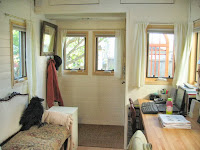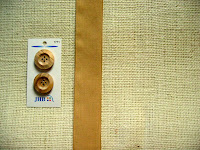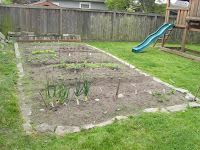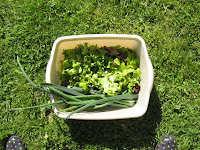Do you have a tiny house blog? When you write something, how many people read it? One way to make a guess at how many folks read it is how many folks comment on it. But if 3 people comment on it, dose that mean only 3 people read it? No. Generally, more people read than comment.
How about followers? Maybe you have statistics that say 40 or so folks "follow" your blog. So does that mean 40 people read your post? Maybe, maybe not. The number could be smaller since of those 40 followers only a fraction will read every post. But the number could be higher because other bloggers may read your post and write about it (generally linking to your blog or the specific post). This may bring other readers to your site.
So lets talk about links. There are two basic kinds of links in the blogosphere. First are the links in blogrolls. These are static, meaning they don't change much. They are also generally strategic - meaning as bloggers we make choices about who we link to (for this post I will not talk about the politics of links, but I might in a future post). The other kind is a citation link. If anyone writes about this post in their blog they will likely follow general blogger etiquette by linking to it. They might say it's all hog-wash, or that it's interesting, but generally most bloggers link to a post that inspires or influences them in their own post.
And those links form a network. I used a tool called the
Issue Crawler to capture the network generated by blogrolls and citations to make a visualization of the blogs that form what is called a topic network. The topic, is, of course, Tiny Houses. Where are you on the map?

So let me tell you what the map means. (Download a large version
here).
First, the map captures the top 50 nodes (blogs) in the Tiny House Issue Network. The size of the node is based on the number of in-links (either from citations or blogrolls). Below I have posted the top 93 sites and the number of in-links that Issue Crawler could find (which may not be every single one). The size and position of the nodes are related to how many in-links that blog has received.
If you make money from advertising (Arlene and I do not) than site traffic is important to you and site traffic is, as we say in statistical parlance, positively related to in-links. That just means that more in-links you have, the more traffic you are likely to have (other things being equal).
I haven't done a formal analysis of this network, so I don't have much else to say about it for now. I will say that some sites on the map (like Wikipedia) may or may not be relevant to the topic network. We could probably make arguments on either side for including this or that site, or not including them. That would depend on the analysis.
So, are you on the top 10 list? Top 93? Issue Crawler only lists and plots sites that have two or more in-links from other sites within the network - so we have a list of 93 blogs and their ranking. Tiny House Blog has a very high number of in-links, so it is central to the map. But some of those links are not from the collection of 93. So the numbers on the map may not match the within-network ranking.
But, anyway, here is the Tiny House Issue Network ranking:
Actor Rankings (core network and periphery, by page)
1 - tinyhouseblog.com - 47
2 - tinyhousedesign.com - 42
3 - tumbleweedhouses.com - 34
4 - resourcesforlife.com - 31
5 - tinyfreehouse.com - 27
6 - michaeljanzen.com - 26
7 - rowdykittens.com - 25
8 - thistinyhouse.com - 22
9 - comingunmoored.com - 21
10 - smalllivingjournal.com - 21
11 - tinyhouseliving.com - 19
12 - ninetinyfeet.com - 18
13 - wordpress.com - 17
14 - paddleways.com - 15
15 - storyofstuff.com - 15
16 - thetinylife.com - 14
17 - tortoiseshellhome.com - 14
18 - shedworking.co.uk - 13
19 - jaystinyhouse.com - 13
20 - smallhousestyle.com - 13
21 - tinypallethouse.com - 12
22 - tinyhouseforum.com - 12
23 - diyfreedom.com - 11
24 - flickr.com - 11
25 - tinyhousejournal.com - 11
26 - apartmenttherapy.com - 11
27 - tinytexashouses.com - 11
28 - littlediggs.com - 11
29 - tinyhousevillage.com - 11
30 - mobilecottage.blogspot.com - 1131 - togetherweareone.com - 10
32 - rosschapin.com - 10
33 - thegreenestdollar.com - 9
34 - theyonderosa.blogspot.com - 9
35 - energystar.gov - 9
36 - greenaerie.blogspot.com - 8
37 - livinglargeinourlittlehouse.com - 8
38 - otherpower.com - 8
39 - relaxshax.wordpress.com - 8
40 - zenhabits.net - 8
41 - microcompacthome.com - 8
42 - lodge-on-wheels.com - 8
43 - kithaus.com - 8
44 - relaxshacks.com - 8
45 - smallhousesociety.org - 8
46 - sustain.ca - 8
47 - martinhousetogo.com - 8
48 - notsobighouse.com - 8
49 - tinyhousetalk.com - 7
50 - juliajanzen.com - 7
51 - weehouse.com - 7
52 - inhabitat.com - 7
53 - moderncabana.com - 7
54 - freecycle.org - 7
55 - truckingpilgrim.blogspot.com - 7
56 - claytonihouse.com - 7
57 - accessahut.wordpress.com - 7
58 - dwell.com - 7
59 - npr.org - 7
60 - time.com - 7
61 - cusatocottages.com - 7
62 - en.wikipedia.org - 6
63 - sonomashanty.com - 6
64 - tinyhouses.net - 6
65 - kmswoodworks.wordpress.com - 6
66 - portlandalternativedwellings.com - 6
67 - claytonhomes.com - 6
68 - littlehouseonasmallplanet.com - 6
69 - projectrollingfreedom.wordpress.com - 6
70 - jenkinspublishing.com - 6
71 - realestatejournal.com - 6
72 - buildingwithawareness.com - 5
73 - projectrollingfreedom.com - 5
74 - felinedesigninc.com - 5
75 - small-house-building.com - 5
76 - lloydkahn-ongoing.blogspot.com - 5
77 - ultimatemoneyblog.com - 5
78 - metaphysics-for-life.com - 5
79 - ebay.com - 5
80 - josephkenyon.com - 5
81 - rocioromero.com - 5
82 - off-grid.se - 5
83 - cobcottage.com - 5
84 - contests.apartmenttherapy.com - 4
85 - coyotecottage.com - 4
86 - cottagecompany.com - 4
87 - bluhomes.com - 4
88 - slowingdown.wordpress.com - 4
89 - ted.com - 4
90 - thescraphouse.wordpress.com - 4
91 - powellriverbooks.blogspot.com - 4
92 - edavies.nildram.co.uk - 4
93 - goyurt.com - 4

.jpg)












